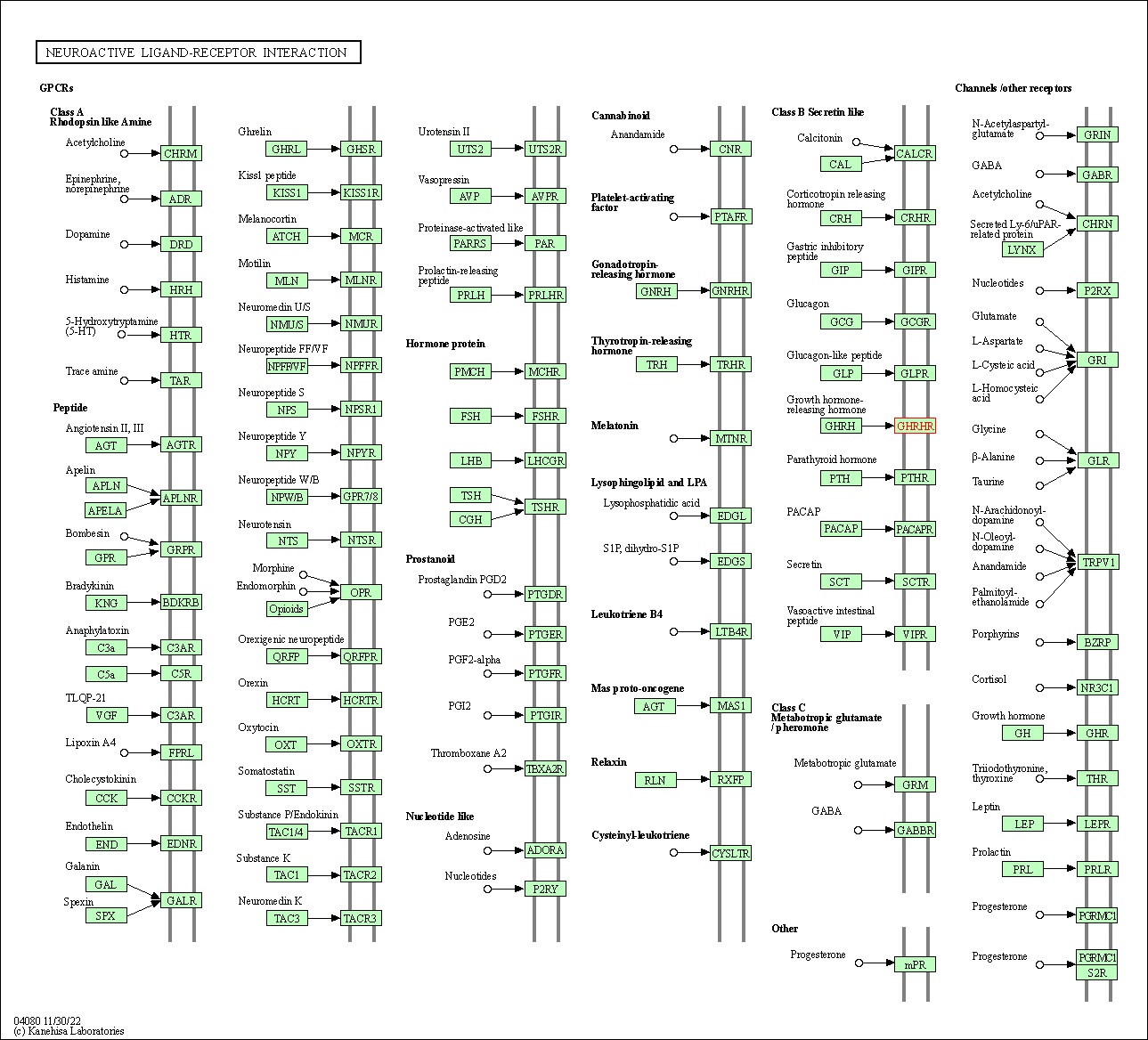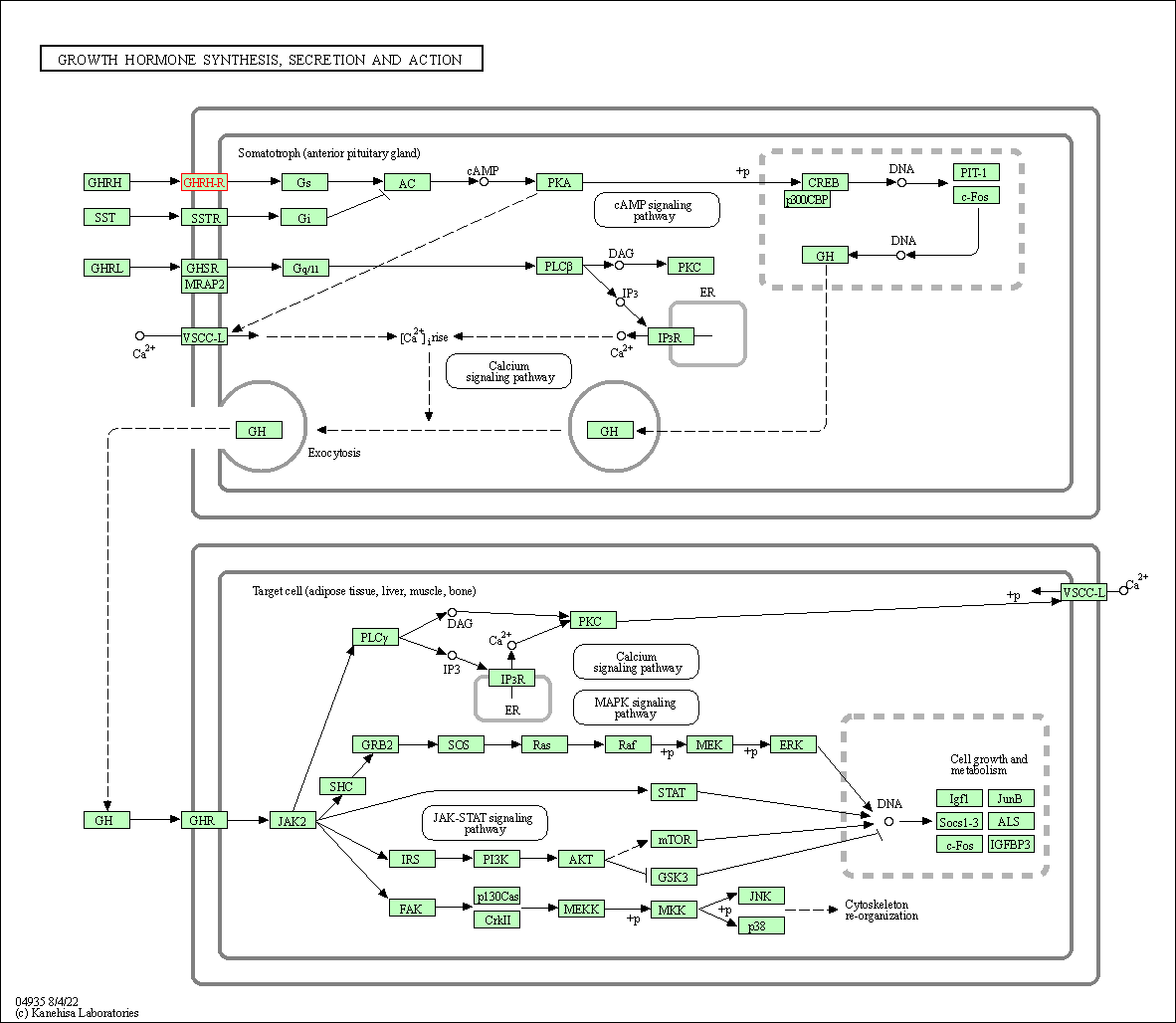Target Information
| Target General Information | Top | |||||
|---|---|---|---|---|---|---|
| Target ID |
T70449
(Former ID: TTDS00446)
|
|||||
| Target Name |
Growth hormone-releasing hormone receptor (GHRHR)
|
|||||
| Synonyms |
GRFR; GRF receptor; GHRHR; GHRH receptor
Click to Show/Hide
|
|||||
| Gene Name |
GHRHR
|
|||||
| Target Type |
Successful target
|
[1] | ||||
| Disease | [+] 2 Target-related Diseases | + | ||||
| 1 | Bone growth disorder [ICD-11: FB86] | |||||
| 2 | Human immunodeficiency virus disease [ICD-11: 1C60-1C62] | |||||
| Function |
Receptor for GRF,coupled to G proteins which activate adenylyl cyclase. Stimulates somatotroph cell growth, growth hormone gene transcription and growth hormone secretion.
Click to Show/Hide
|
|||||
| BioChemical Class |
GPCR secretin
|
|||||
| UniProt ID | ||||||
| Sequence |
MDRRMWGAHVFCVLSPLPTVLGHMHPECDFITQLREDESACLQAAEEMPNTTLGCPATWD
GLLCWPTAGSGEWVTLPCPDFFSHFSSESGAVKRDCTITGWSEPFPPYPVACPVPLELLA EEESYFSTVKIIYTVGHSISIVALFVAITILVALRRLHCPRNYVHTQLFTTFILKAGAVF LKDAALFHSDDTDHCSFSTVLCKVSVAASHFATMTNFSWLLAEAVYLNCLLASTSPSSRR AFWWLVLAGWGLPVLFTGTWVSCKLAFEDIACWDLDDTSPYWWIIKGPIVLSVGVNFGLF LNIIRILVRKLEPAQGSLHTQSQYWRLSKSTLFLIPLFGIHYIIFNFLPDNAGLGIRLPL ELGLGSFQGFIVAILYCFLNQEVRTEISRKWHGHDPELLPAWRTRAKWTTPSRSAAKVLT SMC Click to Show/Hide
|
|||||
| 3D Structure | Click to Show 3D Structure of This Target | PDB | ||||
| HIT2.0 ID | T39NNK | |||||
| Drugs and Modes of Action | Top | |||||
|---|---|---|---|---|---|---|
| Approved Drug(s) | [+] 2 Approved Drugs | + | ||||
| 1 | Sermorelin | Drug Info | Approved | Pediatric growth disorder | [2] | |
| 2 | Tesamorelin | Drug Info | Approved | HIV-associated lipodystrophy | [1], [3] | |
| Discontinued Drug(s) | [+] 4 Discontinued Drugs | + | ||||
| 1 | AKL-0707 | Drug Info | Discontinued in Phase 2 | Lipodystrophy | [4] | |
| 2 | Examorelin | Drug Info | Discontinued in Phase 2 | Growth hormone deficiency | [5], [6] | |
| 3 | L-692429 | Drug Info | Discontinued in Phase 1 | Growth hormone deficiency | [7], [8] | |
| 4 | NNC-26-0762 | Drug Info | Terminated | Growth hormone deficiency | [9] | |
| Mode of Action | [+] 3 Modes of Action | + | ||||
| Binder | [+] 2 Binder drugs | + | ||||
| 1 | Sermorelin | Drug Info | [10], [11] | |||
| 2 | Tesamorelin | Drug Info | [1] | |||
| Agonist | [+] 3 Agonist drugs | + | ||||
| 1 | AKL-0707 | Drug Info | [12] | |||
| 2 | NNC-26-0762 | Drug Info | [15] | |||
| 3 | Mutated growth hormone | Drug Info | [16] | |||
| Modulator | [+] 2 Modulator drugs | + | ||||
| 1 | Examorelin | Drug Info | [13] | |||
| 2 | L-692429 | Drug Info | [2], [14] | |||
| Cell-based Target Expression Variations | Top | |||||
|---|---|---|---|---|---|---|
| Cell-based Target Expression Variations | ||||||
| Drug Binding Sites of Target | Top | |||||
|---|---|---|---|---|---|---|
| Ligand Name: Cholesterol | Ligand Info | |||||
| Structure Description | Cryo-EM structure of the human growth hormone-releasing hormone receptor-Gs protein complex | PDB:7CZ5 | ||||
| Method | Electron microscopy | Resolution | 2.60 Å | Mutation | Yes | [17] |
| PDB Sequence |
LAEEESYFST
128 VKIIYTVGHS138 ISIVALFVAI148 TILVALRRLH158 CPRNYVHTQL168 FTTFILKAGA 178 VFLKDAALFH188 SDDTDHCSFS198 TVLCKVSVAA208 SHFATMTNFS218 WLLAEAVYLN 228 CLLASTSPSS238 RRAFWWLVLA248 GWGLPVLFTG258 TWVSCKLAFE268 DIACWDLDDT 278 SPYWWIIKGP288 IVLSVGVNFG298 LFLNIIRILV308 RKLETQSQYW325 RLSKSTLFLI 335 PLFGIHYIIF345 NFLPDNAGLG355 IRLPLELGLG365 SFQGFIVAIL375 YCFLNQEVRT 385 EISRKWHGH
|
|||||
|
|
||||||
| Click to View More Binding Site Information of This Target with Different Ligands | ||||||
| Different Human System Profiles of Target | Top |
|---|---|
|
Human Similarity Proteins
of target is determined by comparing the sequence similarity of all human proteins with the target based on BLAST. The similarity proteins for a target are defined as the proteins with E-value < 0.005 and outside the protein families of the target.
A target that has fewer human similarity proteins outside its family is commonly regarded to possess a greater capacity to avoid undesired interactions and thus increase the possibility of finding successful drugs
(Brief Bioinform, 21: 649-662, 2020).
Human Pathway Affiliation
of target is determined by the life-essential pathways provided on KEGG database. The target-affiliated pathways were defined based on the following two criteria (a) the pathways of the studied target should be life-essential for both healthy individuals and patients, and (b) the studied target should occupy an upstream position in the pathways and therefore had the ability to regulate biological function.
Targets involved in a fewer pathways have greater likelihood to be successfully developed, while those associated with more human pathways increase the chance of undesirable interferences with other human processes
(Pharmacol Rev, 58: 259-279, 2006).
Biological Network Descriptors
of target is determined based on a human protein-protein interactions (PPI) network consisting of 9,309 proteins and 52,713 PPIs, which were with a high confidence score of ≥ 0.95 collected from STRING database.
The network properties of targets based on protein-protein interactions (PPIs) have been widely adopted for the assessment of target’s druggability. Proteins with high node degree tend to have a high impact on network function through multiple interactions, while proteins with high betweenness centrality are regarded to be central for communication in interaction networks and regulate the flow of signaling information
(Front Pharmacol, 9, 1245, 2018;
Curr Opin Struct Biol. 44:134-142, 2017).
Human Similarity Proteins
Human Pathway Affiliation
Biological Network Descriptors
|
|
|
There is no similarity protein (E value < 0.005) for this target
|
| KEGG Pathway | Pathway ID | Affiliated Target | Pathway Map |
|---|---|---|---|
| Neuroactive ligand-receptor interaction | hsa04080 | Affiliated Target |

|
| Class: Environmental Information Processing => Signaling molecules and interaction | Pathway Hierarchy | ||
| Growth hormone synthesis, secretion and action | hsa04935 | Affiliated Target |

|
| Class: Organismal Systems => Endocrine system | Pathway Hierarchy | ||
| Degree | 1 | Degree centrality | 1.07E-04 | Betweenness centrality | 0.00E+00 |
|---|---|---|---|---|---|
| Closeness centrality | 1.45E-01 | Radiality | 1.18E+01 | Clustering coefficient | 0.00E+00 |
| Neighborhood connectivity | 3.00E+00 | Topological coefficient | 1.00E+00 | Eccentricity | 14 |
| Download | Click to Download the Full PPI Network of This Target | ||||
| Target Affiliated Biological Pathways | Top | |||||
|---|---|---|---|---|---|---|
| KEGG Pathway | [+] 1 KEGG Pathways | + | ||||
| 1 | Neuroactive ligand-receptor interaction | |||||
| Reactome | [+] 2 Reactome Pathways | + | ||||
| 1 | G alpha (s) signalling events | |||||
| 2 | Glucagon-type ligand receptors | |||||
| WikiPathways | [+] 4 WikiPathways | + | ||||
| 1 | GPCRs, Class B Secretin-like | |||||
| 2 | GPCR ligand binding | |||||
| 3 | GPCR downstream signaling | |||||
| 4 | GPCRs, Other | |||||
| References | Top | |||||
|---|---|---|---|---|---|---|
| REF 1 | Mullard A: 2010 FDA drug approvals. Nat Rev Drug Discov. 2011 Feb;10(2):82-5. | |||||
| REF 2 | Drugs@FDA. U.S. Food and Drug Administration. U.S. Department of Health & Human Services. 2015 | |||||
| REF 3 | URL: http://www.guidetopharmacology.org Nucleic Acids Res. 2015 Oct 12. pii: gkv1037. The IUPHAR/BPS Guide to PHARMACOLOGY in 2016: towards curated quantitative interactions between 1300 protein targets and 6000 ligands. (Ligand id: 6959). | |||||
| REF 4 | Trusted, scientifically sound profiles of drug programs, clinical trials, safety reports, and company deals, written by scientists. Springer. 2015. Adis Insight (drug id 800021539) | |||||
| REF 5 | URL: http://www.guidetopharmacology.org Nucleic Acids Res. 2015 Oct 12. pii: gkv1037. The IUPHAR/BPS Guide to PHARMACOLOGY in 2016: towards curated quantitative interactions between 1300 protein targets and 6000 ligands. (Ligand id: 1100). | |||||
| REF 6 | Trusted, scientifically sound profiles of drug programs, clinical trials, safety reports, and company deals, written by scientists. Springer. 2015. Adis Insight (drug id 800003697) | |||||
| REF 7 | URL: http://www.guidetopharmacology.org Nucleic Acids Res. 2015 Oct 12. pii: gkv1037. The IUPHAR/BPS Guide to PHARMACOLOGY in 2016: towards curated quantitative interactions between 1300 protein targets and 6000 ligands. (Ligand id: 5868). | |||||
| REF 8 | Trusted, scientifically sound profiles of drug programs, clinical trials, safety reports, and company deals, written by scientists. Springer. 2015. Adis Insight (drug id 800003647) | |||||
| REF 9 | Trusted, scientifically sound profiles of drug programs, clinical trials, safety reports, and company deals, written by scientists. Springer. 2015. Adis Insight (drug id 800010046) | |||||
| REF 10 | Sermorelin: a better approach to management of adult-onset growth hormone insufficiency Clin Interv Aging. 2006;1(4):307-8. | |||||
| REF 11 | Sermorelin: a review of its use in the diagnosis and treatment of children with idiopathic growth hormone deficiency. BioDrugs. 1999 Aug;12(2):139-57. | |||||
| REF 12 | A super-agonist of growth hormone-releasing hormone causes rapid improvement of nutritional status in patients with chronic kidney disease. Kidney Int. 2010 Mar;77(5):450-8. | |||||
| REF 13 | Hexarelin is a stronger GH-releasing peptide than GHRH in normal cycling women but not in anorexia nervosa. J Endocrinol Invest. 1997 May;20(5):257-63. | |||||
| REF 14 | Nonpeptide and peptide growth hormone secretagogues act both as ghrelin receptor agonist and as positive or negative allosteric modulators of ghrel... Mol Endocrinol. 2005 Sep;19(9):2400-11. | |||||
| REF 15 | Trusted, scientifically sound profiles of drug programs, clinical trials, safety reports, and company deals, written by scientists. Springer. 2015. Adis Insight (drug id 800010046) | |||||
| REF 16 | Treatment strategies for acromegaly. Expert Opin Emerg Drugs. 2005 Nov;10(4):875-90. | |||||
| REF 17 | Structural basis for activation of the growth hormone-releasing hormone receptor. Nat Commun. 2020 Oct 15;11(1):5205. | |||||
If You Find Any Error in Data or Bug in Web Service, Please Kindly Report It to Dr. Zhou and Dr. Zhang.

